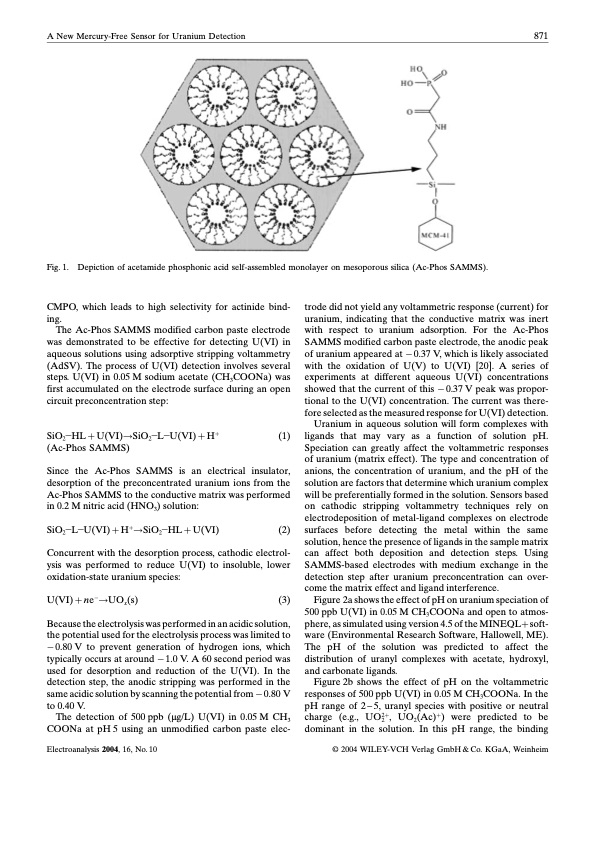
PDF Publication Title:
Text from PDF Page: 002
A New Mercury-Free Sensor for Uranium Detection 871 Fig. 1. Depiction of acetamide phosphonic acid self-assembled monolayer on mesoporous silica (Ac-Phos SAMMS). CMPO, which leads to high selectivity for actinide bind- ing. The Ac-Phos SAMMS modified carbon paste electrode was demonstrated to be effective for detecting U(VI) in aqueous solutions using adsorptive stripping voltammetry (AdSV). The process of U(VI) detection involves several steps. U(VI) in 0.05 M sodium acetate (CH3COONa) was first accumulated on the electrode surface during an open circuit preconcentration step: trode did not yield any voltammetric response (current) for uranium, indicating that the conductive matrix was inert with respect to uranium adsorption. For the Ac-Phos SAMMS modified carbon paste electrode, the anodic peak of uranium appeared at 0.37 V, which is likely associated with the oxidation of U(V) to U(VI) [20]. A series of experiments at different aqueous U(VI) concentrations showed that the current of this 0.37 V peak was propor- tional to the U(VI) concentration. The current was there- fore selected as the measured response for U(VI) detection. Uranium in aqueous solution will form complexes with ligands that may vary as a function of solution pH. Speciation can greatly affect the voltammetric responses of uranium (matrix effect). The type and concentration of anions, the concentration of uranium, and the pH of the solution are factors that determine which uranium complex will be preferentially formed in the solution. Sensors based on cathodic stripping voltammetry techniques rely on electrodeposition of metal-ligand complexes on electrode surfaces before detecting the metal within the same solution, hence the presence of ligands in the sample matrix can affect both deposition and detection steps. Using SAMMS-based electrodes with medium exchange in the detection step after uranium preconcentration can over- come the matrix effect and ligand interference. Figure 2a shows the effect of pH on uranium speciation of 500 ppb U(VI) in 0.05 M CH3COONa and open to atmos- phere, as simulated using version 4.5 of the MINEQL soft- ware (Environmental Research Software, Hallowell, ME). The pH of the solution was predicted to affect the distribution of uranyl complexes with acetate, hydroxyl, and carbonate ligands. Figure 2b shows the effect of pH on the voltammetric responses of 500 ppb U(VI) in 0.05 M CH3COONa. In the pH range of 2 ± 5, uranyl species with positive or neutral SiO2HL U(VI)!SiO2LU(VI) H (Ac-Phos SAMMS) (1) Since the Ac-Phos SAMMS is an electrical insulator, desorption of the preconcentrated uranium ions from the Ac-Phos SAMMS to the conductive matrix was performed in 0.2 M nitric acid (HNO3) solution: SiO2LU(VI) H!SiO2HL U(VI) (2) Concurrent with the desorption process, cathodic electrol- ysis was performed to reduce U(VI) to insoluble, lower oxidation-state uranium species: U(VI) ne!UOx(s) (3) Because the electrolysis was performed in an acidic solution, the potential used for the electrolysis process was limited to 0.80 V to prevent generation of hydrogen ions, which typically occurs at around 1.0 V. A 60 second period was used for desorption and reduction of the U(VI). In the detection step, the anodic stripping was performed in the same acidic solution by scanning the potential from 0.80 V to 0.40 V. charge (e.g., UO2, UO (Ac)) were predicted to be 322 The detection of 500 ppb (mg/L) U(VI) in 0.05 M CH COONa at pH 5 using an unmodified carbon paste elec- dominant in the solution. In this pH range, the binding Electroanalysis 2004, 16, No. 10 1 2004 WILEY-VCH Verlag GmbH & Co. KGaA, WeinheimPDF Image | Carbon Paste Electrode Modified with Carbamoylphosphonic

PDF Search Title:
Carbon Paste Electrode Modified with CarbamoylphosphonicOriginal File Name Searched:
Carbon-Paste-Electrode.pdfDIY PDF Search: Google It | Yahoo | Bing
CO2 Organic Rankine Cycle Experimenter Platform The supercritical CO2 phase change system is both a heat pump and organic rankine cycle which can be used for those purposes and as a supercritical extractor for advanced subcritical and supercritical extraction technology. Uses include producing nanoparticles, precious metal CO2 extraction, lithium battery recycling, and other applications... More Info
Heat Pumps CO2 ORC Heat Pump System Platform More Info
| CONTACT TEL: 608-238-6001 Email: greg@infinityturbine.com | RSS | AMP |